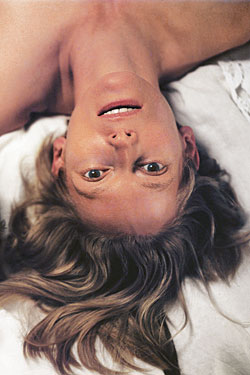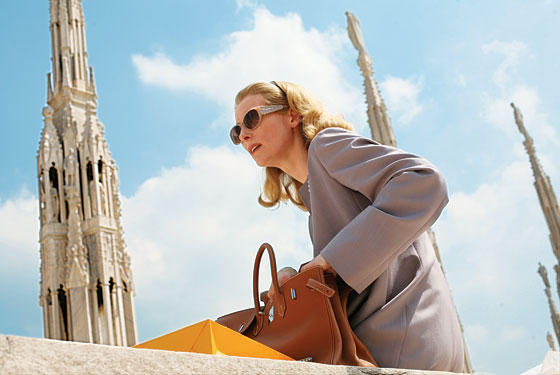
Tilda Swinton first encountered the filmmaker Luca Guadagnino in 1994. She was at home in London, sifting through her mail, and chose to ignore a letter from the Italian filmmaker asking her to be in a short film based on “Penny Arcade Peep Show” from William S. Burroughs’s The Wild Boys: A Book of the Dead.
A few months later, Swinton was in Rome. After participating in a panel about the late film director Derek Jarman (Swinton made her 1986 film debut in his Caravaggio), she noticed an Italian man lingering by her side in the lobby of the theater. “I sort of expected him to peel off,” she says. Swinton decided to ignore him, but he took the gentlest hold of her sleeve and hung on while she finished a conversation. He introduced himself, reminded her of Burroughs and of the letter. “He said, ‘I never made the film, because you never replied.’ ” Swinton narrows her green eyes and wags her finger. “Very clever!”
Swinton and Guadagnino became great friends (Guadagnino, it turns out, has a charm gigantic enough to pull off mild stalking) and began a sixteen-year discussion that resulted, ultimately, in Io Sono L’Amore, or I Am Love, a film that opens next month with Swinton as star and producer. “In these long working relationships with people, the conversations are really the important things,” she says. “The films are like school projects that kind of come off the semester.”
The conversations between Swinton and Guadagnino were mostly about love. “About the revolution of love,” she says, “about the natural grace and the natural brutality of love. The ways in which love can unhand and at the same time destroy things.” Swinton, of course, has a famously complicated—or perhaps supremely uncomplicated—love life of her own. She has lived for a long time in the Scottish countryside, often with John Byrne, an artist, playwright, and author, and their 13-year-old twins. But she also has a relationship with an artist named Sandro Kopp, who is seventeen years younger than she is. These days, they all live on the same road, in separate houses, and are, in Swinton’s words, “a happy family.”
At the moment, Swinton is at the Bowery Hotel, on a very short break (sixteen hours) from the Connecticut set of We Need to Talk About Kevin, a film about mothers, sons, violence. She says she hasn’t slept much, but her eyes and skin are remarkably clear. Her hair, notably changeable, is, for this role, short and jet-black, and she’s wearing a long white kurta over spotless white jeans. “It’s funny that there are people here who only think of me as an actor,” says Swinton, who turns 50 in November. “I never think of myself as an actor.” She considers herself a collaborator, primarily, and even though I Am Love is the first film she’s officially produced, she spends years working behind the scenes to make the projects she believes in happen. But she did, of course, win an Oscar. For acting.
“The Oscar’s a huge mistake, a red herring,” she says of her 2008 best-supporting-actress award for Michael Clayton. “I know most people, whether they act or not, would like to set their sights at standing up in front of 3 billion people accepting a golden statue. I never have, so I feel a little sheepish about it. I’m like the person in Pass the Parcel, like the music stopped at the wrong time.”
In I Am Love, Swinton plays Emma, a Russian woman who has married into the Milanese haute bourgeoisie and, for twenty years, performed the role of Italian matron faultlessly: Her children are charming, her outfits unruffled, and she runs her villa like the conductor of a fine symphony. Among the film’s greatest pleasures are the long shots of uniformed staff moving seamlessly through the house’s corridors and in and out of its many well-oiled doors.
Things begin to unravel when Emma falls in love with a chef, the young friend of her favorite son. (The falling-in-love part goes down over a meal. “Prawn-ography,” Swinton says.) “It’s about a woman of a certain age whose mothering is coming to completion—it’s her reencounter with herself,” Swinton says. “The wheel has turned, she is thrown back on her own resources.” The topic of the female midlife crisis, the debacle of the empty nest, is the stuff of Elizabeth Gilbert and prime-time network TV—not exactly revolutionary. I Am Love’s revelation is to make it so fabulously chic, to set it to the music of John Adams, to watch these problems play across Swinton’s ghostly and incredible face as she glides about in clothing by Raf Simons and carries armfuls of shopping bags from expensive designer shops.

Also: The family lives in a spectacular brutalist Piero Portaluppi villa in the center of Milan that is full up with tapestries, modernist furniture, and a banister straight out of a Fassbinder film. “We imagined the house as part museum, part prison, part castle,” she says. “It’s built for the people in it to behave a certain way.” And all of this luxurious formality is part of the point: The action takes place ten years ago, in the midst of high-capitalist fantasy, scented by Diptyque candles and fueled by Ladurée macarons. “It’s very critical of our addiction to beauty,” Swinton says. “Beauty is tantalizing, that’s the point.” And so the film becomes about nature: human nature, of course, but also the freedom represented by the vegetable gardens and the butterflies and the hills above San Remo, about the happiness available in simplicity.
And simplicity is what attracts Swinton most. It’s apparent in her spartan beauty and her attraction to architectural fashion designers who make big statements with very little (and cause no end of red-carpet debate). But it is especially apparent in her acting. The actress spends a great deal of time thinking about what it means to pretend to be alone when surrounded by the satellite city of a film crew. “I am very interested in a certain aspect of performance, in the idea of trying to affect being unwatched,” she says. “It’s a constant experiment for me. I’m so allergic to seeing acting onscreen. If one has to be banal and think of a favorite filmmaker, mine is Robert Bresson, who so often looks at people who have never seen themselves onscreen and who of course made a film about a donkey, which I think is the greatest performance ever. The donkey. That’s what one should aspire to be: the donkey.”